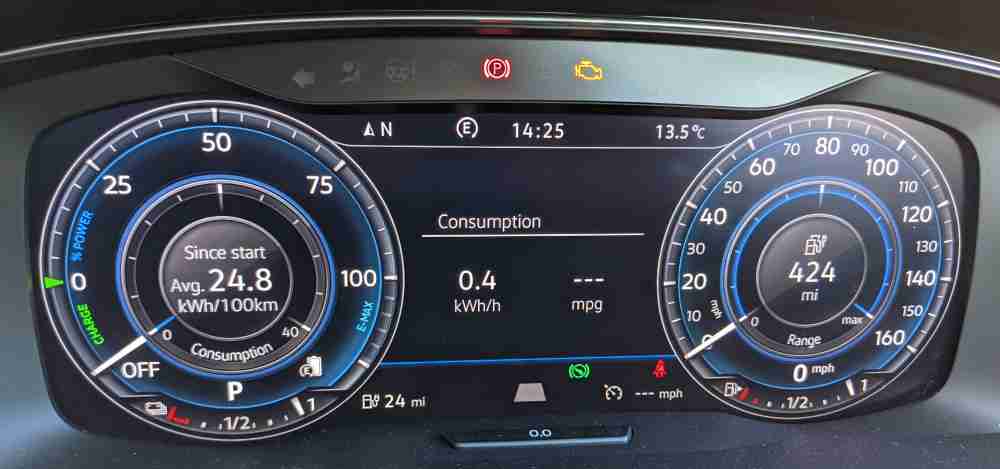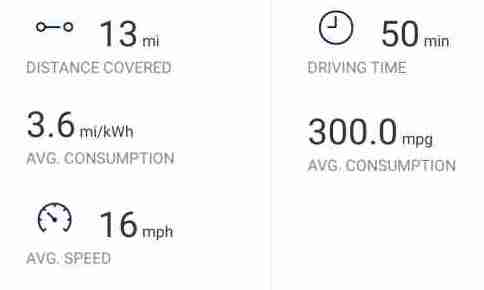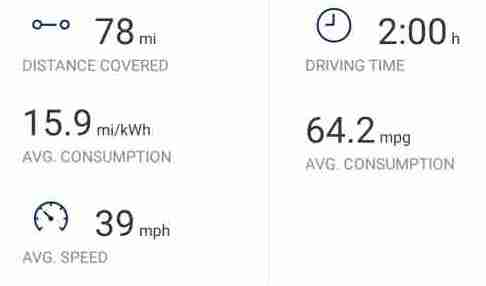Fuel/Energy Consumption
6th October 2021
I just wanted to share with you some initial real-world findings of the fuel/energy consumption of my 2017 GTE Advance, Plug in hybrid electric vehicle (PHEV).

Active Info Display showing an electric range of 24 miles.
Relaxed, Pure-electric energy consumption

Driving Data for a journey in Electric mode
The GTE has an official electric range of 30 miles. After a full charge, most people report they only see an electric range of around 24-25 miles on the dash. I have seen this figure as low as 19 miles if the climate control was used on the last journey. Turning the climate control off can result in the range increasing 1 or 2 miles. I think the electric range must be calculated based upon battery health (age) and recent energy consumption (i.e., accessories such as climate control, radio, wipers, lights, etc. driving style (acceleration/braking), environment (hills/flat), etc.) I suspect ambient temperature may also be a factor but since I’ve only had my car since May, my car hasn’t really seen ambient temperatures below 10C yet.
After an all-electric journey, the Volkswagen We Connect (used to be called Car-Net) app reports something similar to that shown to the right.
This was a journey of 13 miles so well within the car’s all-electric range. There was about 33% of 50-60 MPH driving and the remainder 30 MPH city driving. The average energy consumption is 3.6 miles/kWh which is pretty good (based upon https://en.wikipedia.org/wiki/Plug-in_hybrid_car_energy_efficiency). Remember that I am quite a relaxed driver, anticipating traffic ahead, coasting a lot, light braking and not doing a lot of fast accelerating. The average fuel (petrol) consumption is shown as 300 MPG which is the maximum value possible. Since the petrol engine never switched on, no fuel was actually consumed.
Relaxed Hybrid energy consumption

Driving Data for a journey in Hybrid mode
A frequent journey of mine is a 34 mile-ish trip from the flat-lands of York to hillier Bradford, and back again. Each way is approximately 50% out-of-town driving anywhere between 40 and 60 MPH and the remainder city driving at 30 MPH. On the day the following journey was recorded, it was ideal conditions: Daylight (no headlights), dry (no rain) and also pleasant temperatures so I think I turned the Climate Control off.
94.2 MPG average fuel consumption is an impressive figure, but not normal. Normal is more like in the 70’s. Still pretty impressive and this beats my 1.6 TDI Golf Mk 7 which would usually be in the 60’s.
Average energy consumption is 13.8 miles/kWh. This figure is way higher than what you could expect from a pure-electric vehicle and is solely down to the energy recuperation which is achieved on the back of petrol-engine running. More about this later.
A longer, faster journey

Driving Data for a fast journey in Hybrid mode, starting with a full charge.
I recently made a longer, faster journey with no opportunity to recharge the battery once the initial full charge had been consumed, so it was interesting to compare.
This was the outbound 78 mile journey comprising about 47 miles motorway driving at 70 MPH and the remainder at between 30-50 MPH. Off the motorway it was also quite hilly so lots of opportunity for the car to recuperate some energy.
64.2 MPG is an impressive figure for such fast driving. In Hybrid mode, the car was mainly propelled by the petrol engine on the motorway, but frequently turning off to coast whilst going downhill or when decelerating. The electric motor was used frequently when driving through town around 30 MPH. Again the 15.9 mi/kWh shows that a large amount of energy recuperation was going on.

Driving Data for a fast journey in Hybrid mode, starting with no charge.
Compare that to the return journey which was started with no charge in the battery. Whilst the petrol engine was used more, there were still many opportunities to run on electric. For example, when setting off from junctions, short sections of 30mph driving, following long descents – one of which recuperated 2 miles of electric range. Since all the electric running on this trip was using solely recuperated energy, the average energy consumption is shown as 99.9 miles/kWh (the maximum figure).
Note that the fuel consumption at 56.5 MPG, whilst still impressive for a 1.4 TSI petrol engine, is no doubt because of either the assistance the petrol engine gets from the electric motor or from the electric motor taking entirely at slow speeds, queuing traffic, etc. However it is down on the 64.2 MPG achieved on the outward journey when the journey began with a full battery.
Summary
I wasn't expecting the GTE to be so economical. With a full charge, the electric motor can either take over the propulsion entirely or assist the petrol engine to achieve impressive fuel consumption figures. But even setting off on a journey with no charge, the amount of energy recuperation means the electric motor is still able to help out.